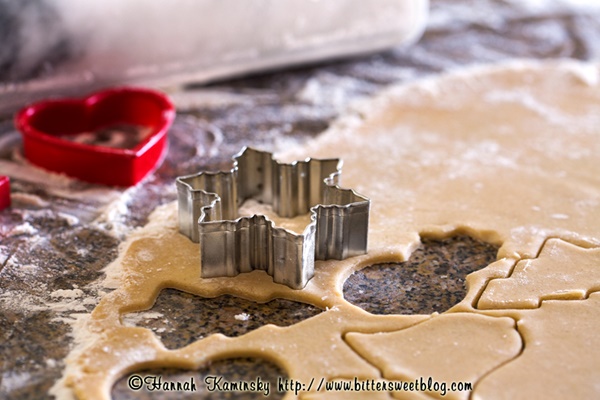Call it a blank canvas but don’t you dare call it bland; the dairy-free sugar cookies have volumes of flavor to speak of when done the right way.
Through countless centuries of culinary experimentation, the classic sugar cookie has truly withstood the test of time. Subtly evolving to keep pace with modern tastes, early European bakers might not recognize it anymore, but it truly hasn’t strayed far from its origins. Originally little more than a coarse, crumbly biscuit of flour, sugar, lard, and eggs, the first sugar cookies have more in common with thick slabs of pie dough than the frosting-slathered decadent morsels we tend to associate them with today.
 It takes all sorts to soothe the sweet tooth, so while crunchy cut-outs with a buttery, shortbread-like consistency may stay truer to tradition, I prefer a softer incarnation. But balancing this desire with the demands of crafting a dough sturdy enough to hold its shape through rolling, cutting, baking, and beyond is no small task.
It takes all sorts to soothe the sweet tooth, so while crunchy cut-outs with a buttery, shortbread-like consistency may stay truer to tradition, I prefer a softer incarnation. But balancing this desire with the demands of crafting a dough sturdy enough to hold its shape through rolling, cutting, baking, and beyond is no small task.
Luckily, ingredient innovations have changed the game in recent years, a new arsenal of previously unheard of flours unleashing textures and flavors unattainable by earlier cooks. Oh, so you want to know the secret ingredient that brings these cookies together? Sorghum flour.
Lending strength and toothsome density without additional gluten that would toughen the delicate dough, its subtly sweet, nutty essence only enhances the complexity of the nuanced flavor profile. Vanilla dominates with a gentle, floral rule, allowing each of the few elements to shine through. In such a simple cookie, every last addition counts. There’s nowhere to hide unsavory elements in this basic formula for dairy-free sugar cookies.

No, icing isn’t optional here, but that doesn’t mean that decorating needs to be a big ordeal. Just stick with a simple white base and keep it thick enough to pipe out neatly. Adding colors later on through tinted sugars and springs will bring the designs to life, without creating heaps of extra work, or dirty dishes to tackle later.
They may bear little resemblance to their early ancestors, but no matter how you cut them, soft, tender dairy-free sugar cookies deserve a place on the table for many years to come.
Special Diet Notes & Options: Dairy-Free Sugar Cookies
This recipe is dairy-free / non-dairy, egg-free, peanut-free, soy-free, tree nut-free, vegan and vegetarian. Just be sure to choose your ingredients wisely. Some dairy-free margarines do contain soy, but their are soy-free options, including two from Earth Balance. Also, many of the dairy-free margarine products do contain pea protein – consult a physician to ensure that peas are safe if peanut allergy is a concern for you.
- 1 cup dairy-free margarine (see notes in post above)
- 1-1/2 cups granulated sugar
- 3 cups all-purpose flour
- ¾ cup sorghum flour
- 2 tablespoons arrowroot powder/starch
- ½ teaspoon salt
- ½ teaspoon baking powder
- 2 teaspoons vanilla extract
- ¼ to ⅓ cup plain dairy-free milk alternative
- 2 cups confectioner’s sugar
- 2 tablespoons cornstarch
- ½ teaspoon vanilla extract
- Water, as needed and used sparingly
- Use your stand mixer to thoroughly cream the margarine and sugar together.
- In a separate bowl, sift the flour, sorghum flour, arrowroot, salt, and baking powder, stirring well to combine.
- Add about half of these dry ingredients into the mixing bowl, processing it until fully incorporated. Pour in the vanilla, followed by ¼ cup of the non-dairy milk and the remaining flour mixture. Continue to mix until it forms smooth, homogeneous dough, slowly drizzling in additional non-dairy milk if necessary.
- Form the dough into two equal balls, flatten them out a bit into smooth disks, wrap separately in plastic and chill for at least one 1 hour before proceeding.
- After the dough has had time to rest in the refrigerator, start heating your oven to 350ºF.
- On a lightly floured surface, roll out one disk of dough to about ⅛-inch thickness.
- Use cookie cutters of any shape you desire to cut the cookies, but try to keep them all approximately the same size so that they bake evenly.
- Transfer the shapes to baking sheets lined with silpats or parchment paper. Gather up the scraps, re-roll the dough and repeat as necessary. Work with only one disk of dough at a time to keep it cool and easy to handle; allow the first batch to finish baking before rolling out the next.
- Bake for about 8 to 12 minutes, depending on the size of your cookies. Keep a close eye on them and don't let them turn brown. The edges should be firm, tops no longer glossy, and the centers soft and slightly puffed up when they're done.
- Cool completely before decorating and/or storing in an air-tight container at room temperature.
- For the royal icing, simply combine the confectioner’s sugar, cornstarch, and vanilla in a medium bowl. Add in water, one teaspoon at a time, stirring thoroughly after each addition, until it reaches a pipe-able consistency. Be sure to take this process slowly, as just one drop too much liquid can make the icing runny.
- Allow a full 24 hours for the icing to completely harden.


16 Comments
Pingback: Classic Dairy-Free Sugar Cookies: A Favorite Family Recipe
These taste amazing! No one would know that they’re vegan! Thanks! 🙂
This is one amazing and very tasty cookie recipe. Other dairy free cookie recipe and plain and can’t hold its shape this one is perfect just like gingerbread dough. Thank you, my son totally love them.
Fantastic! So glad you and your son loved this recipe Scott!
Hello
To make the cookies V as well as GF can you substitute GF ground oat flour fir regular flour? Thank you. I do a lot of baking and usually substitute GF oat flour and all the goodies are delicious.
Janis, the results will certainly vary and likely be more crumbly fragile. If it generally yields satisfactory results for you, though, feel free to give it a try!
Pingback: Leftover Links: December Edition | BitterSweet
LOVE THESE so much! I could eat my computer screen! Beautifully executed …Awesome cookies.
What is the purpose for the sorghum flour or arrowroot powder/starch? I do not have them on hand. Can I just use more of the all-purpose flour? If not, what can I use as a replacement?
Hi Colleen – it states in the post, but I will ask Hannah to reply with options.
The sorghum flour and arrowroot are what give the cookies their soft, chewy texture and make up the foundation of the recipe. It would be tough to make recommendations on what to substitute for the sorghum without testing it out first, but I think that finely ground oat flour might be your best bet. You could use more all-purpose flour, but it would change the texture and yield crunchier cookies.
Oh and make your own powdered sugar by whizzing it in a coffee grinder or blender. Most commercial powdered sugar has corn in it!
Thanks Michelle!
Yum! For those of that also have to be corn free not sure what sub you could use for the EB soy free margerine. :/ yet you can sub arrowroot for cornstarch. Also sub half tsp cream of tarter and quarter tsp baking soda for each tsp baking powder needed. Check online to make sure the measurements, tho!
I can not find a print button . Please help
It’s right under the photo in the recipe.